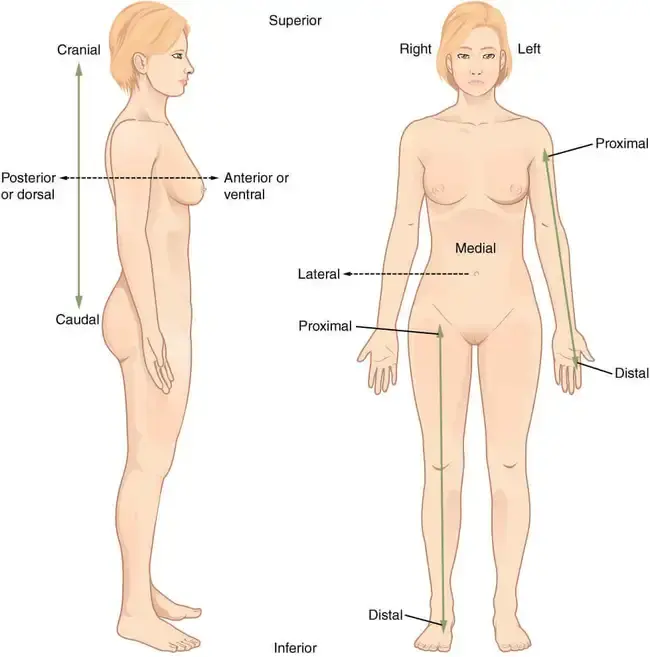
The Language of Anatomy: Understanding Anatomical Position & Directions
Introduction
Understanding anatomy starts with learning its language. The anatomical position serves as a universal reference point, while anatomical directions help describe the precise location of body structures. Mastering these terms is essential for professionals in sports medicine, fitness, and rehabilitation.
Anatomical Position: The Standard Reference
The anatomical position is a standardized way to describe the body’s orientation:
- Standing upright
- Head and eyes facing forward
- Arms at the sides with palms facing forward
- Feet together and parallel
This position acts as a “map orientation” for discussing body structures accurately.
Anatomical Directions: Navigating the Body
Anatomical directions describe a structure’s location relative to others. These terms always come in pairs of opposites:
| Term | Meaning | Opposite |
|---|---|---|
| Superior | Toward the head | Inferior (Toward the feet) |
| Medial | Toward the midline | Lateral (Away from the midline) |
| Anterior | Toward the front | Posterior (Toward the back) |
| Proximal | Closer to the body’s center | Distal (Farther from the center) |
| Cranial | Toward the head | Caudal (Toward the tail) |
| Supine | Lying face up | Prone (Lying face down) |
| Dorsal | On the back/top | Ventral (On the front/bottom) |
Using these terms, we can precisely describe the location of organs. For example, the stomach is:
- Inferior to the liver and superior to the transverse colon
- Posterior (deep) to the abdominal wall
- Anterior (superficial) to the pancreas and spine
Why Does Anatomy Feel Like a New Language?
Anatomy students often compare learning these terms to studying a new language. That’s because most anatomical terms come from Latin and Greek. Just like learning vocabulary in a foreign language, repetition and practice are key!
Tips for Learning Anatomical Terms:
✔️ Make flashcards
✔️ Quiz yourself or a friend
✔️ Use interactive exercises like “Anatomy Simon Says”
Essential Knowledge for Health & Fitness Professionals
A strong foundation in anatomical terminology is crucial for various fields, including:
✔️ Personal Training
✔️ Physical Therapy & Rehabilitation
✔️ Chiropractic Care
✔️ Sports Medicine
✔️ Massage Therapy
✔️ Occupational Therapy
✔️ Yoga & Group Exercise Instruction
This knowledge is fundamental for courses in movement analysis, strength training, rehabilitation, and sports performance.
Next Steps: Planes of Motion
Now that you understand anatomical positions and directions, the next step is learning about planes of motion—how the body moves in space. Stay tuned for Lesson 2: Planes of Motion in our Introduction to Functional Anatomy series!
Bibliography
- Donald A. Neumann, “Kinesiology of the Musculoskeletal System: Foundations of Rehabilitation – 2nd Edition” © 2012 Mosby, Inc.
- Tom Myers, Anatomy Trains: Second Edition. © Elsevier Limited 2009
- David G. Simons, Janet Travell, Lois S. Simons, Travell & Simmons’ Myofascial Pain and Dysfunction, The Trigger Point Manual, Volume 1. Upper Half of Body: Second Edition,© 1999 Williams and Wilkens
- Cynthia C. Norkin, D. Joyce White, Measurement of Joint Motion: A Guide to Goniometry – Third Edition. © 2003 by F.A. Davis Company
- Cynthia C. Norkin, Pamela K. Levangie, Joint Structure and Function: A Comprehensive Analysis: Fifth Edition © 2011 F.A. Davis Company
- Carolyn Richardson, Paul Hodges, Julie Hides. Therapeutic Exercise for Lumbo Pelvic Stabilization – A Motor Control Approach for the Treatment and Prevention of Low Back Pain: 2nd Edition (c) Elsevier Limited, 2004
- Andrew Biel, Trail Guide to the Human Body: 4th Edition, © 2010
- David B. Jenkins, Hollinshead’s Functional Anatomy of the Limbs and Back: Eighth Edition © 2002 Saunders
- John V. Basmajian, Carlo J. De Luca. Muscles Alive: Their Function Revealed by ElectroMyography. 1985
RELATED POSTS
View all



